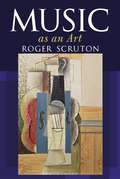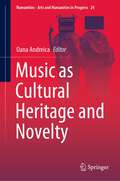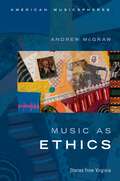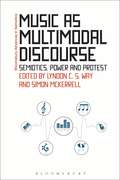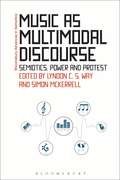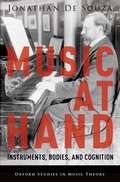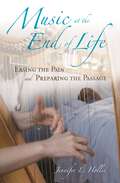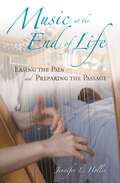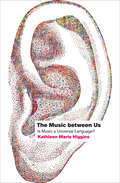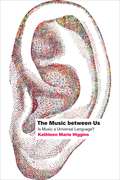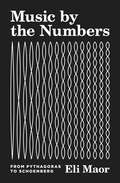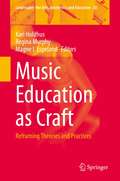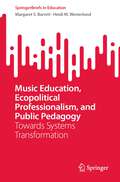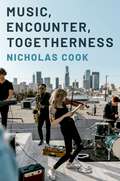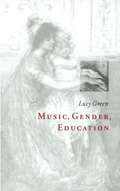- Table View
- List View
Music as an Art
by Sir Roger ScrutonMusic as an Art begins by examining music through a philosophical lens, engaging in discussions about tonality, music and the moral life, music and cognitive science and German idealism, as well as recalling the author's struggle to encourage his students to distinguish the qualities of good music. Scruton then explains – via erudite chapters on Schubert, Britten, Rameau, opera and film – how we can develop greater judgement in music, recognising both good taste and bad, establishing musical values, as well as musical pleasures.As Scruton argues in this book, in earlier times, our musical culture had secure foundations in the church, the concert hall and the home; in the ceremonies and celebrations of ordinary life, religion and manners. Yet we no longer live in that world. Fewer people now play instruments and music is, for many, a form of largely solitary enjoyment. As he shows in Music as an Art, we live at a critical time for classical music, and this book is an important contribution to the debate, of which we stand in need, concerning the place of music in Western civilization.
Music as Cultural Heritage and Novelty (Numanities - Arts and Humanities in Progress #24)
by Oana AndreicaThis book provides a multifaceted view on the relation between the old and the new in music, between tradition and innovation. This is a much-debated issue, generating various ideas and theories, which rarely come to unanimous conclusions. Therefore, the book offers diverse perspectives on topics such as national identities, narrative strategies, the question of musical performance and musical meaning. Alongside themes of general interest, such as classical repertoire, the music of well-established composers and musical topics, the chapters of the book also touch on specific, but equally interesting subjects, like Brazilian traditions, Serbian and Romanian composers and the lullaby. While the book is mostly addressed to researchers, it can also be recommended to students in musicology, ethnomusicology, musical performance, and musical semiotics.
Music as Ethics: Stories from Virginia (AMERICAN MUSICSPHERES SERIES)
by Andrew McGrawMusic as Ethics offers a comparative ethnography of the relationship of music to ethics in four communities in Virginia, covering a wide range of demographic contexts and musical repertoires. Holy Cross Monastery in Berryville is a small community of fifteen Trappist monks who follow the rule of St. Benedict, composed in the early sixth century. Twin Oaks in Louisa is a ninety-member intentional community, founded in 1967, dedicated to egalitarianism. The "Sanctuary" in the Richmond city jail is a community of approximately forty residents drawn from two of the facility's dorms. Richmond is the state capital, with a fraught history of racial inequality. To say that we can experience music "as" ethics means that we can hold several, culturally informed attitudes about music's ethical meanings and functions. While music's relationship to ethical life differs between each community, the case studies suggest that we can all grow as ethical individuals and communities if we pay close attention to music's ethical potential. But as long as our experience of music as ethics remains implicit and vague, we miss an opportunity to fully realize its ethical affordances. More than that, we also expose ourselves to manipulation by those who would wield music (and other "affective" means) for their own social agenda.
Music as Ethics: Stories from Virginia (AMERICAN MUSICSPHERES SERIES)
by Andrew McGrawMusic as Ethics offers a comparative ethnography of the relationship of music to ethics in four communities in Virginia, covering a wide range of demographic contexts and musical repertoires. Holy Cross Monastery in Berryville is a small community of fifteen Trappist monks who follow the rule of St. Benedict, composed in the early sixth century. Twin Oaks in Louisa is a ninety-member intentional community, founded in 1967, dedicated to egalitarianism. The "Sanctuary" in the Richmond city jail is a community of approximately forty residents drawn from two of the facility's dorms. Richmond is the state capital, with a fraught history of racial inequality. To say that we can experience music "as" ethics means that we can hold several, culturally informed attitudes about music's ethical meanings and functions. While music's relationship to ethical life differs between each community, the case studies suggest that we can all grow as ethical individuals and communities if we pay close attention to music's ethical potential. But as long as our experience of music as ethics remains implicit and vague, we miss an opportunity to fully realize its ethical affordances. More than that, we also expose ourselves to manipulation by those who would wield music (and other "affective" means) for their own social agenda.
Music as Multimodal Discourse: Semiotics, Power and Protest (Bloomsbury Advances in Semiotics)
by Lyndon C. Way Simon McKerrellWe communicate multimodally. Everyday communication involves not only words, but gestures, images, videos, sounds and of course, music. Music has traditionally been viewed as a separate object that we can isolate, discuss, perform and listen to. However, much of music's power lies in its use as multimodal communication. It is not just lyrics which lend songs their meaning, but images and musical sounds as well. The music industry, governments and artists have always relied on posters, films and album covers to enhance music's semiotic meaning. Music as Multimodal Discourse: Semiotics, Power and Protest considers musical sound as multimodal communication, examining the interacting meaning potential of sonic aspects such as rhythm, instrumentation, pitch, tonality, melody and their interrelationships with text, image and other modes, drawing upon, and extending the conceptual territory of social semiotics. In so doing, this book brings together research from scholars to explore questions around how we communicate through musical discourse, and in the discourses of music. Methods in this collection are drawn from Critical Discourse Analysis, Social Semiotics and Music Studies to expose both the function and semiotic potential of the various modes used in songs and other musical texts. These analyses reveal how each mode works in various contexts from around the world often articulating counter-hegemonic and subversive discourses of identity and belonging.
Music as Multimodal Discourse: Semiotics, Power and Protest (Bloomsbury Advances in Semiotics)
by Lyndon C. Way Simon McKerrellWe communicate multimodally. Everyday communication involves not only words, but gestures, images, videos, sounds and of course, music. Music has traditionally been viewed as a separate object that we can isolate, discuss, perform and listen to. However, much of music's power lies in its use as multimodal communication. It is not just lyrics which lend songs their meaning, but images and musical sounds as well. The music industry, governments and artists have always relied on posters, films and album covers to enhance music's semiotic meaning. Music as Multimodal Discourse: Semiotics, Power and Protest considers musical sound as multimodal communication, examining the interacting meaning potential of sonic aspects such as rhythm, instrumentation, pitch, tonality, melody and their interrelationships with text, image and other modes, drawing upon, and extending the conceptual territory of social semiotics. In so doing, this book brings together research from scholars to explore questions around how we communicate through musical discourse, and in the discourses of music. Methods in this collection are drawn from Critical Discourse Analysis, Social Semiotics and Music Studies to expose both the function and semiotic potential of the various modes used in songs and other musical texts. These analyses reveal how each mode works in various contexts from around the world often articulating counter-hegemonic and subversive discourses of identity and belonging.
Music at Hand: Instruments, Bodies, and Cognition (Oxford Studies in Music Theory)
by Jonathan De SouzaFrom prehistoric bone flutes to pipe organs to digital synthesizers, instruments have been important to musical cultures around the world. Yet, how do instruments affect musical organization? And how might they influence players' bodies and minds? Music at Hand explores these questions with a distinctive blend of music theory, psychology, and philosophy. Practicing an instrument, of course, builds bodily habits and skills. But it also develops connections between auditory and motor regions in a player's brain. These multi-sensory links are grounded in particular instrumental interfaces. They reflect the ways that an instrument converts action into sound, and the ways that it coordinates physical and tonal space. Ultimately, these connections can shape listening, improvisation, or composition. This means that pianos, guitars, horns, and bells are not simply tools for making notes. Such technologies, as creative prostheses, also open up possibilities for musical action, perception, and cognition. Throughout the book, author Jonathan De Souza examines diverse musical case studies-from Beethoven to blues harmonica, from Bach to electronic music-introducing novel methods for the analysis of body-instrument interaction. A companion website supports these analytical discussions with audiovisual examples, including motion-capture videos and performances by the author. Written in lucid prose, Music at Hand offers substantive insights for music scholars, while remaining accessible to non-specialist readers. This wide-ranging book will engage music theorists and historians, ethnomusicologists, organologists, composers, and performers-but also psychologists, philosophers, media theorists, and anyone who is curious about how musical experience is embodied and conditioned by technology.
Music at Hand: Instruments, Bodies, and Cognition (Oxford Studies in Music Theory)
by Jonathan De SouzaFrom prehistoric bone flutes to pipe organs to digital synthesizers, instruments have been important to musical cultures around the world. Yet, how do instruments affect musical organization? And how might they influence players' bodies and minds? Music at Hand explores these questions with a distinctive blend of music theory, psychology, and philosophy. Practicing an instrument, of course, builds bodily habits and skills. But it also develops connections between auditory and motor regions in a player's brain. These multi-sensory links are grounded in particular instrumental interfaces. They reflect the ways that an instrument converts action into sound, and the ways that it coordinates physical and tonal space. Ultimately, these connections can shape listening, improvisation, or composition. This means that pianos, guitars, horns, and bells are not simply tools for making notes. Such technologies, as creative prostheses, also open up possibilities for musical action, perception, and cognition. Throughout the book, author Jonathan De Souza examines diverse musical case studies-from Beethoven to blues harmonica, from Bach to electronic music-introducing novel methods for the analysis of body-instrument interaction. A companion website supports these analytical discussions with audiovisual examples, including motion-capture videos and performances by the author. Written in lucid prose, Music at Hand offers substantive insights for music scholars, while remaining accessible to non-specialist readers. This wide-ranging book will engage music theorists and historians, ethnomusicologists, organologists, composers, and performers-but also psychologists, philosophers, media theorists, and anyone who is curious about how musical experience is embodied and conditioned by technology.
Music at the End of Life: Easing the Pain and Preparing the Passage (Religion, Health, and Healing)
by Jennifer L. HollisA practicing music thanatologist provides an insider's history of this remarkable profession, which combines music, medicine, and spirituality to help the terminally ill and their families face the end of life.Reflecting on the author's experiences as a music-thanatologist, Jennifer Hollis's Music at the End of Life: Easing the Pain and Preparing the Passage is an enlightening and emotional examination of the ways in which the experience of dying can be transformed with music.Music at the End of Life highlights the unique role music has come to play in hospice and palliative medicine. Jennifer Hollis interweaves narrative memoir, the personal experiences of fellow music-thanatologists and caregivers, and extensive research to demonstrate the transformative power of music when curing is no longer an option. Through story after unforgettable story, Hollis offers a new vision of end-of-life care, in which music creates a beautiful space for the work of letting go, grieving, and saying goodbye.
Music at the End of Life: Easing the Pain and Preparing the Passage (Religion, Health, and Healing)
by Jennifer L. HollisA practicing music thanatologist provides an insider's history of this remarkable profession, which combines music, medicine, and spirituality to help the terminally ill and their families face the end of life.Reflecting on the author's experiences as a music-thanatologist, Jennifer Hollis's Music at the End of Life: Easing the Pain and Preparing the Passage is an enlightening and emotional examination of the ways in which the experience of dying can be transformed with music.Music at the End of Life highlights the unique role music has come to play in hospice and palliative medicine. Jennifer Hollis interweaves narrative memoir, the personal experiences of fellow music-thanatologists and caregivers, and extensive research to demonstrate the transformative power of music when curing is no longer an option. Through story after unforgettable story, Hollis offers a new vision of end-of-life care, in which music creates a beautiful space for the work of letting go, grieving, and saying goodbye.
The Music between Us: Is Music a Universal Language?
by Kathleen Marie HigginsFrom our first social bonding as infants to the funeral rites that mark our passing, music plays an important role in our lives, bringing us closer to one another. In The Music between Us, philosopher Kathleen Marie Higgins investigates this role, examining the features of human perception that enable music’s uncanny ability to provoke, despite its myriad forms across continents and throughout centuries, the sense of a shared human experience. Drawing on disciplines such as philosophy, psychology, musicology, linguistics, and anthropology, Higgins’s richly researched study showcases the ways music is used in rituals, education, work, healing, and as a source of security and—perhaps most importantly—joy. By participating so integrally in such meaningful facets of society, Higgins argues, music situates itself as one of the most fundamental bridges between people, a truly cross-cultural form of communication that can create solidarity across political divides. Moving beyond the well-worn takes on music’s universality, The Music between Us provides a new understanding of what it means to be musical and, in turn, human.
The Music between Us: Is Music a Universal Language?
by Kathleen Marie HigginsFrom our first social bonding as infants to the funeral rites that mark our passing, music plays an important role in our lives, bringing us closer to one another. In The Music between Us, philosopher Kathleen Marie Higgins investigates this role, examining the features of human perception that enable music’s uncanny ability to provoke, despite its myriad forms across continents and throughout centuries, the sense of a shared human experience. Drawing on disciplines such as philosophy, psychology, musicology, linguistics, and anthropology, Higgins’s richly researched study showcases the ways music is used in rituals, education, work, healing, and as a source of security and—perhaps most importantly—joy. By participating so integrally in such meaningful facets of society, Higgins argues, music situates itself as one of the most fundamental bridges between people, a truly cross-cultural form of communication that can create solidarity across political divides. Moving beyond the well-worn takes on music’s universality, The Music between Us provides a new understanding of what it means to be musical and, in turn, human.
The Music between Us: Is Music a Universal Language?
by Kathleen Marie HigginsFrom our first social bonding as infants to the funeral rites that mark our passing, music plays an important role in our lives, bringing us closer to one another. In The Music between Us, philosopher Kathleen Marie Higgins investigates this role, examining the features of human perception that enable music’s uncanny ability to provoke, despite its myriad forms across continents and throughout centuries, the sense of a shared human experience. Drawing on disciplines such as philosophy, psychology, musicology, linguistics, and anthropology, Higgins’s richly researched study showcases the ways music is used in rituals, education, work, healing, and as a source of security and—perhaps most importantly—joy. By participating so integrally in such meaningful facets of society, Higgins argues, music situates itself as one of the most fundamental bridges between people, a truly cross-cultural form of communication that can create solidarity across political divides. Moving beyond the well-worn takes on music’s universality, The Music between Us provides a new understanding of what it means to be musical and, in turn, human.
The Music between Us: Is Music a Universal Language?
by Kathleen Marie HigginsFrom our first social bonding as infants to the funeral rites that mark our passing, music plays an important role in our lives, bringing us closer to one another. In The Music between Us, philosopher Kathleen Marie Higgins investigates this role, examining the features of human perception that enable music’s uncanny ability to provoke, despite its myriad forms across continents and throughout centuries, the sense of a shared human experience. Drawing on disciplines such as philosophy, psychology, musicology, linguistics, and anthropology, Higgins’s richly researched study showcases the ways music is used in rituals, education, work, healing, and as a source of security and—perhaps most importantly—joy. By participating so integrally in such meaningful facets of society, Higgins argues, music situates itself as one of the most fundamental bridges between people, a truly cross-cultural form of communication that can create solidarity across political divides. Moving beyond the well-worn takes on music’s universality, The Music between Us provides a new understanding of what it means to be musical and, in turn, human.
The Music between Us: Is Music a Universal Language?
by Kathleen Marie HigginsFrom our first social bonding as infants to the funeral rites that mark our passing, music plays an important role in our lives, bringing us closer to one another. In The Music between Us, philosopher Kathleen Marie Higgins investigates this role, examining the features of human perception that enable music’s uncanny ability to provoke, despite its myriad forms across continents and throughout centuries, the sense of a shared human experience. Drawing on disciplines such as philosophy, psychology, musicology, linguistics, and anthropology, Higgins’s richly researched study showcases the ways music is used in rituals, education, work, healing, and as a source of security and—perhaps most importantly—joy. By participating so integrally in such meaningful facets of society, Higgins argues, music situates itself as one of the most fundamental bridges between people, a truly cross-cultural form of communication that can create solidarity across political divides. Moving beyond the well-worn takes on music’s universality, The Music between Us provides a new understanding of what it means to be musical and, in turn, human.
The Music between Us: Is Music a Universal Language?
by Kathleen Marie HigginsFrom our first social bonding as infants to the funeral rites that mark our passing, music plays an important role in our lives, bringing us closer to one another. In The Music between Us, philosopher Kathleen Marie Higgins investigates this role, examining the features of human perception that enable music’s uncanny ability to provoke, despite its myriad forms across continents and throughout centuries, the sense of a shared human experience. Drawing on disciplines such as philosophy, psychology, musicology, linguistics, and anthropology, Higgins’s richly researched study showcases the ways music is used in rituals, education, work, healing, and as a source of security and—perhaps most importantly—joy. By participating so integrally in such meaningful facets of society, Higgins argues, music situates itself as one of the most fundamental bridges between people, a truly cross-cultural form of communication that can create solidarity across political divides. Moving beyond the well-worn takes on music’s universality, The Music between Us provides a new understanding of what it means to be musical and, in turn, human.
The Music between Us: Is Music a Universal Language?
by Kathleen Marie HigginsFrom our first social bonding as infants to the funeral rites that mark our passing, music plays an important role in our lives, bringing us closer to one another. In The Music between Us, philosopher Kathleen Marie Higgins investigates this role, examining the features of human perception that enable music’s uncanny ability to provoke, despite its myriad forms across continents and throughout centuries, the sense of a shared human experience. Drawing on disciplines such as philosophy, psychology, musicology, linguistics, and anthropology, Higgins’s richly researched study showcases the ways music is used in rituals, education, work, healing, and as a source of security and—perhaps most importantly—joy. By participating so integrally in such meaningful facets of society, Higgins argues, music situates itself as one of the most fundamental bridges between people, a truly cross-cultural form of communication that can create solidarity across political divides. Moving beyond the well-worn takes on music’s universality, The Music between Us provides a new understanding of what it means to be musical and, in turn, human.
Music by the Numbers: From Pythagoras to Schoenberg
by Eli MaorHow music has influenced mathematics, physics, and astronomy from ancient Greece to the twentieth centuryMusic is filled with mathematical elements, the works of Bach are often said to possess a math-like logic, and Igor Stravinsky said "musical form is close to mathematics," while Arnold Schoenberg, Iannis Xenakis, and Karlheinz Stockhausen went further, writing music explicitly based on mathematical principles. Yet Eli Maor argues that music has influenced math at least as much as math has influenced music. Starting with Pythagoras, proceeding through the work of Schoenberg, and ending with contemporary string theory, Music by the Numbers tells a fascinating story of composers, scientists, inventors, and eccentrics who played a role in the age-old relationship between music, mathematics, and the sciences, especially physics and astronomy. Music by the Numbers explores key moments in this history, particularly how problems originating in music have inspired mathematicians for centuries. Perhaps the most famous of these problems is the vibrating string, which pitted some of the greatest mathematicians of the eighteenth century against each other in a debate that lasted more than fifty years and that eventually led to the development of post-calculus mathematics. Other highlights in the book include a comparison between meter in music and metric in geometry, complete with examples of rhythmic patterns from Bach to Stravinsky, and an exploration of a suggestive twentieth-century development: the nearly simultaneous emergence of Einstein's theory of relativity and Schoenberg's twelve-tone system.Weaving these compelling historical episodes with Maor's personal reflections as a mathematician and lover of classical music, Music by the Numbers will delight anyone who loves mathematics and music.
Music by the Numbers: From Pythagoras to Schoenberg
by Eli MaorHow music has influenced mathematics, physics, and astronomy from ancient Greece to the twentieth centuryMusic is filled with mathematical elements, the works of Bach are often said to possess a math-like logic, and Igor Stravinsky said "musical form is close to mathematics," while Arnold Schoenberg, Iannis Xenakis, and Karlheinz Stockhausen went further, writing music explicitly based on mathematical principles. Yet Eli Maor argues that music has influenced math at least as much as math has influenced music. Starting with Pythagoras, proceeding through the work of Schoenberg, and ending with contemporary string theory, Music by the Numbers tells a fascinating story of composers, scientists, inventors, and eccentrics who played a role in the age-old relationship between music, mathematics, and the sciences, especially physics and astronomy. Music by the Numbers explores key moments in this history, particularly how problems originating in music have inspired mathematicians for centuries. Perhaps the most famous of these problems is the vibrating string, which pitted some of the greatest mathematicians of the eighteenth century against each other in a debate that lasted more than fifty years and that eventually led to the development of post-calculus mathematics. Other highlights in the book include a comparison between meter in music and metric in geometry, complete with examples of rhythmic patterns from Bach to Stravinsky, and an exploration of a suggestive twentieth-century development: the nearly simultaneous emergence of Einstein's theory of relativity and Schoenberg's twelve-tone system.Weaving these compelling historical episodes with Maor's personal reflections as a mathematician and lover of classical music, Music by the Numbers will delight anyone who loves mathematics and music.
Music Education as Craft: Reframing Theories and Practices (Landscapes: the Arts, Aesthetics, and Education #30)
by Kari Holdhus Regina Murphy Magne I. EspelandThis book is a collection of leading international authors in the field of music education taking the concept of 'craft' as a starting point to deconstruct and reconstruct their understanding of the practices and theories of music education. Their insights draw from deep wells of resources located in historical, philosophical, epistemological, musicological and educational traditions that lead to rich and complex insights on the evolving field of music education. In so doing, they generate a constellation of new understandings and illustrations of what crafts can mean in this field. Historically, the idea of craft was typically associated with a skill or experience in knowing how to do or make something, or an activity of some kind that requires specific professional skills. In Old Norse, the concept for craft was kraptr, meaning strength and virtue, while Old English and continental use was associated with power and physical strength, as well as skill. When these definitions of ‘crafts’ are infused into contemporary understandings of the field of music education as a professional field, a whole new set of possible interpretations are unearthed. Such insights are not exhaustive, but rather, point the way in which this professional, diverse, inclusive and ambiguous field might continue to evolve in the 21st century.
Music Education, Ecopolitical Professionalism, and Public Pedagogy: Towards Systems Transformation (SpringerBriefs in Education)
by Margaret S. Barrett Heidi M. WesterlundThis book challenges the dominant expertise professionalism rationale for music education by responding to the call to develop ‘ecological awareness’ at a time when all professions have a moral obligation to place sustainable and interdependent life at the center. The book aims to expand music education’s professional horizons to acknowledge the responsibility of the music field to contribute to the demands of complex questions of sustainability and identify the ways in which sustainable music education may be strengthened through an activist relational ecological stance. It suggests a radical moral turn by asking: What if music education is recognised as part of the problem of sustaining unsustainability? and What if music teacher education was developed in and through dialogue with a futures perspective? These questions are interrogated through a critical analysis of the historical positioning of music in education and an interdisciplinary application of theories of ecology and professionalism.
Music, Encounter, Togetherness
by Nicholas CookIn today's technological and globalised world, music remains a basic dimension of society. Music, Encounter, Togetherness outlines a relational approach to music that creates space for both human agency and social relationship. Throughout the book, author Nicholas Cook puts Euro-American musical traditions into dialogue with other world music cultures, complementing theory-driven approaches with comprehensive case studies ranging from late eighteenth-century India to contemporary China, and from Debussy's encounter with Javanese music and dance to cross-cultural musicking in Australia and in cyberspace. Through these examples, Cook examines how music affords interpersonal relationship and social togetherness, and what happens when musicians from different cultures interact. Central to the book is the idea of encounter, which highlights the dynamic and processual nature of musicking, as much in therapy or at home as in the jazz club or concert hall. Western musicologists have traditionally thought of music as primarily a repertory of objects; Cook illustrates how thinking of it in processual terms--through an expanded idea of performance--can make as much sense of Western art music as of other traditions. In basing an understanding of music on acts rather than objects and focussing on people and their relationships rather than on the impersonal forces of evolutionary or stylistic histories, the book opens up ways of thinking that counter some of the dehumanising aspects of musical thinking and practice in global modernity.
Music, Encounter, Togetherness
by Nicholas CookIn today's technological and globalised world, music remains a basic dimension of society. Music, Encounter, Togetherness outlines a relational approach to music that creates space for both human agency and social relationship. Throughout the book, author Nicholas Cook puts Euro-American musical traditions into dialogue with other world music cultures, complementing theory-driven approaches with comprehensive case studies ranging from late eighteenth-century India to contemporary China, and from Debussy's encounter with Javanese music and dance to cross-cultural musicking in Australia and in cyberspace. Through these examples, Cook examines how music affords interpersonal relationship and social togetherness, and what happens when musicians from different cultures interact. Central to the book is the idea of encounter, which highlights the dynamic and processual nature of musicking, as much in therapy or at home as in the jazz club or concert hall. Western musicologists have traditionally thought of music as primarily a repertory of objects; Cook illustrates how thinking of it in processual terms--through an expanded idea of performance--can make as much sense of Western art music as of other traditions. In basing an understanding of music on acts rather than objects and focussing on people and their relationships rather than on the impersonal forces of evolutionary or stylistic histories, the book opens up ways of thinking that counter some of the dehumanising aspects of musical thinking and practice in global modernity.
Music, Gender, Education (PDF)
by Lucy GreenThis book focuses on the role of education in relation to music and gender. Invoking a concept of musical patriarchy and a theory of the social construction musical meanings, Lucy Green shows how women's musical practices and gendered musical meanings have been reproduced, hand in hand, through history. Covering a wide range of music, including classical, jazz and popular styles, Dr Green uses ethnographic methods to convey the everyday interactions and experiences of girls, boys, and their teachers. She views the contemporary school music classroom as a microcosm of the wider society, and reveals the participation of music education in the continued production and reproduction of gendered musical practices and meanings.
Music, Health, And Wellbeing: (pdf)
by Gunter Kreutz Laura Mitchell Raymond MacDonaldThe great saxophonist Charlie Parker once proclaimed "if you don't live it, it won't come out of your horn". This quote has often been used to explain the hedonistic lifestyle of many jazz greats; however, but it also signals the reciprocal and inextricable relationship between music and wider social, cultural and psychological variables. This link is complex and multifaceted and is undoubtedly a central component of why music has been implicated as a therapeutic agent in vast swathes of contemporary research studies. Music is always about more than just acoustic events or notes on a page. Music has a universal and timeless potential to influence how we feel. Yet, only recently, have researchers begun to explore and understand the positive effects that music can have on our wellbeing - across a range of cultures and musical genres. This book brings together research from music psychology, therapy, public health, and medicine, to explore the relationship between music, health and wellbeing. It presents a range of chapters from internationally recognised experts, resulting in a comprehensive, multidisciplinary, and pluralistic account of recent advances and applications in both clinical and non-clinical practice and research. Some of the questions explored include: what is the nature of the scientific evidence to support the relationship between music, health and wellbeing? What are the current views from different disciplines on empirical observations and methodological issues concerning the effects of musical interventions on health-related processes?
